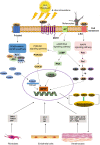New Mechanistic Insights of Melasma
- PMID: 36817641
- PMCID: PMC9936885
- DOI: 10.2147/CCID.S396272
New Mechanistic Insights of Melasma
Abstract
Melasma is a common acquired disorder of pigmentation that negatively impacts quality of life. Present treatments show poor therapeutic effect with frequent recurrence. This in large part is due to the currently limited understanding of the disease's etiology. It is urgent to elucidate the pathogenesis of melasma to further the discovery of new therapeutic strategies. Recent studies show that melasma is triggered or aggravated by a variety of factors, including genetic susceptibility, ultraviolet radiation, and sex hormone dysregulation. Ultraviolet B radiation upregulates the expression of several melanocyte-specific genes and stimulates the release of key factors that participate in the synthesis of melanin. There is a significant increase in melanin in both the epidermal and dermal layers of affected skin, possibly due to abnormalities in crosstalk between the melanocytes and other cells. Melanogenesis is regulated through various signaling networks including the Wnt/β-catenin, PI3K/Akt, cAMP/PKA, and SCF/c-kit-mediated signaling pathways. In addition, inflammatory mediators, oxidative stress, neuroactive molecules, sebocytes, etc, have also been proved to be related to the pathogenesis of melasma. This review provides a comprehensive update on the current understanding of the pathogenesis of melasma.
Keywords: genetic predisposition; melanocyte; melasma; sex hormone; ultraviolet.
© 2023 Liu et al.
Conflict of interest statement
The authors declare no conflicts of interest in this work.
Figures

References
Publication types
LinkOut - more resources
Full Text Sources

